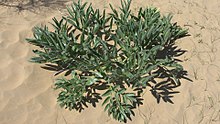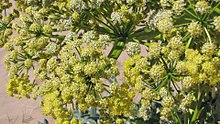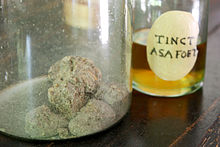Asant
| Asant | ||||||||||||
|---|---|---|---|---|---|---|---|---|---|---|---|---|

Asant ( Ferula assa-foetida ) in Uzbekistan |
||||||||||||
| Systematics | ||||||||||||
|
||||||||||||
| Scientific name | ||||||||||||
| Ferula assa-foetida | ||||||||||||
| L. |
Asant ( Ferula assa-foetida ), also known as Stinkasant or Teufelsdreck , is a species of plant in the umbelliferae family (Apiaceae). The distribution area extends from southern Iran , Afghanistan , Turkmenistan , Uzbekistan to western Pakistan and India. Occurrences are also reported from Libya.
description

Vegetative characteristics
The asante grows as a perennial, trimonomic , monocarpic (plants that bloom and fruit only once before they die) herbaceous plant and reaches heights of 1.5 to 3 m. It forms a stiff, upright and up to 10 cm thick, bare, round, light green and furrowed stem with a spongy, whitish pith (succulent, hollow) and a large, thick, fleshy, durable taproot . The whole plant has a smelly smell and has a smelly milky sap .
The relatively large, rosette-like leaves at the base , smaller, alternate and often sloping at the top, are arranged in leaf sheath , petiole and leaf blade. The leaf blade is bi-pinnate. The shiny, leathery and dark green part leaflet are schmaleiförmig to eilanzettlich and rundspitzig or rounded, blunt edge with whole.
Generative characteristics
The long-stemmed, multi-rayed double-ended female or polygamous mixed inflorescences are compact and terminally assembled into a large, spherical inflorescence. There are often large bracts with leaf sheaths on the lower umbel stalks . The flowers have a double, five-fold flower envelope . The durable petals are whitish in the female flowers, yellow in the male and hermaphrodite. The male and mostly sterile hermaphroditic flowers have five curved stamens and a stunted ovary fused with the fine-haired, bell-shaped flower base . The rudimentary ovary has a depressed stylus foot without scars at the tip. The female flowers have no stamens, but a small five-lobed, edged ring at the top of the ovary. The calyx of all flowers consists of five distant, small, pointed teeth. The two-chambered ovary, which is fused with the bell-shaped, finely hairy flower base, is below; there are two basal, conical fused and outward-curved styles with a heady stigma. The anthers are attached subbasifix to the filament. Orange-brown double achaines are formed, the individual, flattened, grooved achenes are elongated to elliptical with a length of up to 2 cm and a width of about 0.8 cm with short wings that are almost as wide as the seeds.
The chromosome number is 2n = 22.
Taxonomy
Ferula assa-foetida was first published in 1753 by Carl von Linné in Species Plantarum , 1, page 248. Synonyms for Ferula assa-foetida L. , often also written Ferula asa-foetida , are: Ferula foetida St.-Lag. , Scorodosma foetidum Bunge .
use
harvest
When cutting into the exposed, approximately 15 cm thick “rootstock”, Asant supplies a gum resin that tastes strongly of garlic . The stinky milky sap emerging from the roots is dried in the sun and then resinified. It turns yellowish to orange-brown. The “harvest” of the juice takes 2 to 3 months and results in a yield of around 1 kg per plant specimen.
Medicine and spice
Asantharz is often used as a spice in Afghanistan , Pakistan , Iran and India , but especially in Indian cuisine . It is also part of the Worcestershire sauce .
The asante drug , the yellowish to orange-brown gum resin "Asa foetida" (devil's dirt), consists of 24 to 65% resin, gum and 6-16% essential oil , which contains, among other things, asaresinotannol , its ferulic acid ester and vanillin . The resin content is z. T. responsible for the bitter, pungent taste and the very unpleasant smell, which, however, changes into a smell similar to that of onions and garlic when used .
Stinkasant or its juice was already used in Mesopotamian medicine.
According to Madaus , the asant is often mentioned in Sanskrit scriptures under the name "Hingu". As a spice and remedy, Dioscurides is probably a substitute for Silphium , the uses of which were later transferred to it. Paracelsus recommended Asant for fumigating plague houses. In Lonicerus and Matthiolus , it promotes saliva and sputum, helps with epilepsy , asthma, cough, spleen pain, daily fever and internal ulcers. Von Haller praises him for nerve-related uterine problems. Hecker's practical medicine theory of 1815 names it for asthenic breast and digestive diseases, general convulsive affections, to stimulate menstruation, against scrofula , internally and externally for caries, ulcers and cancer. Hufeland and co-workers called it “dissolving and anticonvulsant”, and used it to treat bone damage and tapeworms, for example . Rademacher used it with Nux vomica for colic . Clarus lists it as a carminative , anthelmintic , antispasmodic , emmenagogue and expectorant , Kobert as an anti-abortive that reduces the nervous excitability of the uterus. The Mongolian medicine used asafetida with parasites and diseases under normal temperature. It was also used in veterinary medicine for deworming, and also as an incense for lung worms . According to Bentley and Trimen , it has been tried and tested in the chorea of dogs. According to Lewin, overdoses manifested themselves in lip swelling, smelly belching, gas, diarrhea , but also headaches, dizziness and increased libido . The Homeopathy knows asafoetida with blackish ulcers due to varicose veins, with great excitability.
At the latest by the author of the year 659 of 22 doctors, " Tang -Arzneibuch" (唐本草) a drug in the Chinese pharmacopoeia was inserted, later the "A wèi" (阿魏) wore and their parent plant name as Ferula assa-foetida interpreted has been. In the 16th century the doctor Li Shizhen gave the following indications for the asant in his pharmacopoeia Bancao Gangmu : "Kills small worms, eliminates stinking breath, breaks hardening, diverts harmful" Qi "downwards, detoxifies." In the pharmacopoeia of the PR China From 1985, these indications are taken over and interpreted as: “Blockages and accumulations due to meat dishes, lumps in the stomach, abdominal pain due to worm accumulations.” The dosage for internal use is 1–1.5 g. Existing pregnancy is mentioned as a contraindication.
The dried gum resin of the Asant is mainly the supplier of Asa foetida, which for centuries has been an integral part of the medicinal treasure in Europe, the Middle East, Persia , India and China. The German Pharmacopoeia 6 from 1926 still lists Asafoetida and provides the corresponding test specifications. In addition to its pharmaceutical and medical use, the asant was also anchored in popular belief and popular healing knowledge. In addition to the raw drug Asa foetida, the corresponding Asa foetida oil and alcohol extracts were used medicinally ; in addition, the gum was used as a smoking drug. Indications for use were
- a) various anxiety and nervous disorders (nervousness, hysteria , hypochondria ),
- b) crampy stomach, liver and gallbladder diseases,
- c) Impotence and reduced sexual drive.
As a result, Asant was mainly used as a nerve and sedative and as a gastrointestinal antispasmodic. Asa foetida has also been an aphrodisiac since ancient times and has been used in love magic for centuries.
Asante is especially popular with Indian Brahmins , who are forbidden to consume onions and garlic. In Ayurvedic cuisine, it is used under the trade name Asafoetida together with 70 - 80% ground fenugreek .
If today people cook according to recipes of the Roman cuisine , asafoetida tincture is used as a substitute for the no longer available laser picium or its juice, which is simply called "laser".
Military use
From the late Middle Ages to the early modern period , Asant u. A. used as a component of a flammable mixture of different substances in so-called stink pots as a weapon or ordnance. The foul-smelling and, depending on the composition, sometimes even poisonous smoke from these mixtures should impair the opponent and force them to give up. In contemporary fireworks books, Asant is mentioned several times as an integral part of such mixtures.
See also
- List of culinary herbs and aromatic plants
- Silphium , which was replaced by Asanth.
Web links
- Gernot Katzer's spice pages : Asant .
- Ferula assa-foetida from Useful Temperate Plants, accessed January 26, 2018.
- Johann Bartholomäus Trommsdorff : The art of pharmacy in all its scope according to alphabetical order . Volume 3: N-S . Henning, Erfurt 1812, p. 869 ( limited preview in Google Book search).
Individual evidence
- ↑ cf. exemplary: Gerd and Marlene Haerkötter: Hexenfurz and Teufelsdreck. Herbs of love, healing and poison: witchcraft, recipes and stories. 4th edition, Eichborn, Frankfurt a. M. 1987, ISBN 978-3-8218-1055-3 .
- ↑ a b c d Eugene Nasir: Umbelliferae. Volume 20, 1972, Ferula assa-foetida at Tropicos.org. In: Flora of Pakistan . Missouri Botanical Garden, St. Louis
- ^ Ferula in the Germplasm Resources Information Network (GRIN), USDA , ARS , National Genetic Resources Program. National Germplasm Resources Laboratory, Beltsville, Maryland. Retrieved May 15, 2018.
- ^ R. Hand (2011): Apiaceae. - In: Euro + Med Plantbase - the information resource for Euro-Mediterranean plant diversity. Datasheet Ferula
- ↑ G. Gintzburger, KN Toderich, BK Mardonov, MM Mahmudov: Rangelands of the Arid and Semi-arid Zones in Uzbekistan. CIRAD, 2003, ISBN 2-87614-555-3 , p. 93.
- ↑ F. Golmohammadi, S. Esmaeel Ghoreyshi, H. Parvaneh: Ferula assa-foetida as a main medical plant in east of Iran (harvesting, main characteristics and economical importance). In: Intl. J. Farm. & Alli. Sci. Vol. 5 (6), 2016, pp. 453–475, online (PDF), from International Journal of Farming and Allied Sciences, accessed on January 26, 2018.
- ^ Otto Karl Berg , CF Schmidt: Presentation and description of all officinal plants listed in the Pharmacopaea Borussica. Fourth volume, Forstner, 1863, T. XXVI c. u. d., limited preview in Google Book Search.
- ↑ a b Ferula assa-foetida at Tropicos.org. Missouri Botanical Garden, St. Louis, Retrieved December 2, 2017.
- ↑ Johann Daniel Friedrich Rumpf , Carl Lang : New picture gallery for young sons and daughters for pleasant and useful self-employment from the realms of nature, art, customs, and common life . tape 12 . Oehmigcke the Younger, Berlin 1804, p. 14 ( limited preview in Google Book search).
- ^ A b S. Facciola: Cornucopia - A Source Book of Edible Plants. Kampong Publications, 1990, ISBN 0-9628087-0-9 . Quoted in: Ferula foetida at Plants For A Future . Retrieved March 24, 2013.
- ↑ a b Gerhard Madaus: Textbook of biological remedies. Volume I, Olms, Hildesheim / New York 1979, ISBN 3-487-05891-X , pp. 614–619 (reprint of the Leipzig 1938 edition).
- ↑ G. Arends, H. Zörnig, G. Frerichs: Hagers Handbook of Pharmaceutical Practice . First volume. Springer, 1938, ISBN 978-3-642-90728-9 , pp. 588 ( limited preview in Google Book search).
- ↑ Martha Haussperger : A small compendium from ancient Babylonian times. In: Würzburg medical history reports. Volume 16, 1997, pp. 131-149; here: p. 132.
- ↑ Julius Berendes . Pedanius Dioscurides' medicine theory in 5 books. Enke, Stuttgart 1902, pp. 316-320 (Book III, Chapter 84) Silphion (digitized version )
- ↑ Adam Lonitzer. Kreuterbuch. Artificial Conterfeytunge of the trees / perennials / hedges / Kreuter / Getreyde / Gewürtze: With specific description of the same name / Underscheyd / Shape Natural power and effect ... Christian Egenolffs Erben, Frankfurt am Main 1557. Edition 1564, sheet 61v: Teufelstreck (digitalisat)
- ^ Pietro Andrea Mattioli (Georg Handsch, translator). New Kreüterbuch: With the most beautiful and most artful figures of all Gewechss, such a thing never mentioned before in no one spoke . Prague 1563, sheet 312v: Teuffelsdreck (digital copy )
- ↑ August Friedrich Hecker's practical medicine theory . Part II, Vienna 1815, pp. 175–180: Asa foetida (digitized version )
- ^ Johann Gottfried Rademacher. Empirical doctrine . 2nd edition, Berlin 1846, Volume I, pp. 258–260: Stinkender Asantine with nasty nut tincture for colic . (Digitized version)
- ↑ Robert Bentley and Henry Trimen . Medicinal plants. J. & A. Churchill, London 1880, Volume II, No 126 (digitized)
- ↑ Georgos Vithoulkas: Homeopathic Medicines. Materia Medica Viva. Volume III, Urban & Fischer, Munich 2009, ISBN 978-3-437-55061-4 , pp. 239-261.
- ↑ Li Shizhen. Bencao gangmu. 1596, Volume 34 (Annotated Edition Peking, Volume III, p. 1969)
- ↑ George Arthur Stuart. Chinese Materia Medica. Vegetable Kindom. Shanghai 1911, pp. 173-74. Ferula (digitized version)
- ↑ Zhong hua ren min gong he guo. Pharmacopoeia of the PR China 1985 , Vol. I, p. 155
- ↑ Lisa Takler: Volatile compounds and antimicrobial effects of selected resins and balms from A – J. Diploma thesis, Univers. Vienna, 2015, pp. 105–112, online (PDF; 3.18 MB), at updata.univie.ac.at, accessed on November 1, 2016.
- ↑ M. Smollich: The drug Asa foetida - a historical nerve remedy and aphrodisiac. GRIN, 2009, ISBN 978-3-640-26174-1 .
- ↑ a b T. Vierich, T. Vilgis: Aroma: The art of seasoning . 3. Edition. Stiftung Warentest, 2015, ISBN 978-3-86851-755-2 , p. 109 ( limited preview in Google Book search).




